过去时态句型转换
- 格式:docx
- 大小:16.68 KB
- 文档页数:3
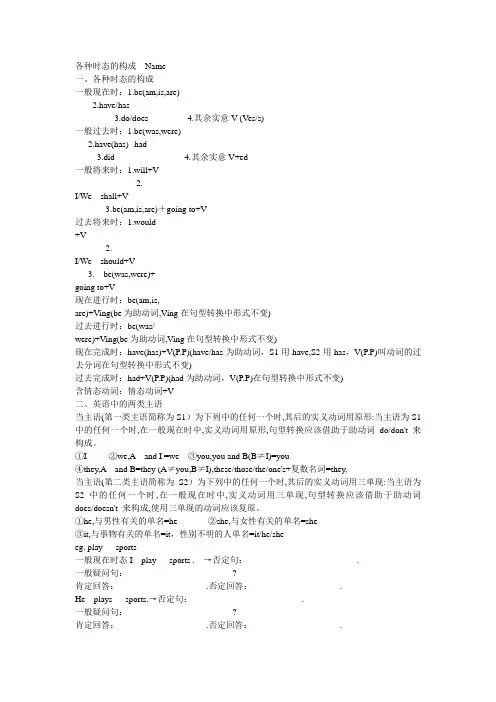
各种时态的构成Name_________一、各种时态的构成一般现在时:1.be(am,is,are)2.have/has3.do/does4.其余实意V (Ves/s)一般过去时:1.be(was,were)2.have(has)--had3.did4.其余实意V+ed一般将来时:1.will+V2.I/We shall+V3.be(am,is,are)+going to+V过去将来时:1.would+V2.I/We should+V3. be(was,were)+going to+V现在进行时:be(am,is,are)+Ving(be为助动词,Ving在句型转换中形式不变)过去进行时:be(was/were)+Ving(be为助动词,Ving在句型转换中形式不变)现在完成时:have(has)+V(P.P)(have/has为助动词,S1用have,S2用has,V(P.P)叫动词的过去分词在句型转换中形式不变)过去完成时:had+V(P.P)(had为助动词,V(P.P)在句型转换中形式不变)含情态动词:情态动词+V二、英语中的两类主语当主语(第一类主语简称为S1)为下列中的任何一个时,其后的实义动词用原形:当主语为S1中的任何一个时,在一般现在时中,实义动词用原形,句型转换应该借助于助动词do/don't 来构成。
①I ②we,A and I =we ③you,you and B(B≠I)=you④they,A and B=they (A≠you,B≠I),these/those/the/one's+复数名词=they,当主语(第二类主语简称为S2)为下列中的任何一个时,其后的实义动词用三单现:当主语为S2中的任何一个时,在一般现在时中,实义动词用三单现,句型转换应该借助于助动词does/doesn't 来构成,使用三单现的动词应该复原。
①he,与男性有关的单名=he ②she,与女性有关的单名=she③it,与事物有关的单名=it,性别不明的人单名=it/he/sheeg. play sports一般现在时态I play sports . →否定句:_________________________.一般疑问句:________________________?肯定回答:____________________.否定回答:____________________.He plays sports.→否定句:_________________________.一般疑问句:________________________?肯定回答:____________________.否定回答:____________________.一般过去时态I played sports . →否定句:_________________________.一般疑问句:________________________?肯定回答:____________________.否定回答:____________________.He played sports.→否定句:_________________________.一般疑问句:________________________?肯定回答:____________________.否定回答:____________________.一般将来时态I will/shall play sports. →否定句:_________________________.一般疑问句:________________________?肯定回答:____________________.否定回答:____________________.I am going to play sports.→否定句:_________________________.一般疑问句:________________________?肯定回答:____________________.否定回答:____________________.He will play sports. →否定句:_________________________.一般疑问句:________________________?肯定回答:____________________.否定回答:____________________.He is going to play sports.→否定句:_________________________.一般疑问句:________________________?肯定回答:____________________.否定回答:____________________.过去将来时态I would/should play sports. I was going to play sports.He would play sports. He was going to play sports. 现在进行时态I am playing sports . →否定句:_________________________.一般疑问句:________________________?肯定回答:____________________.否定回答:____________________.He is playing sports.→否定句:_________________________.一般疑问句:________________________?肯定回答:____________________.否定回答:____________________.过去进行时态I was playing sports.→否定句:_________________________.一般疑问句:________________________?肯定回答:____________________.否定回答:____________________.He was playing sports.→否定句:_________________________.一般疑问句:________________________?肯定回答:____________________.否定回答:____________________.现在完成时态I have played sports. →否定句:_________________________. 一般疑问句:________________________?肯定回答:____________________.否定回答:____________________.He has played sports.→否定句:_________________________.一般疑问句:________________________?肯定回答:____________________.否定回答:____________________.过去完成时态I had played sports. →否定句:_________________________. 一般疑问句:________________________?肯定回答:____________________.否定回答:____________________.He had played sports.→否定句:_________________________.一般疑问句:________________________?肯定回答:____________________.否定回答:____________________.三、用下列动词词组造句1.play computer games →plays→playing→played→played一般现在时态I____________________________ He______________________一般过去时态I____________________________ He______________________一般将来时态I____________________________ /I____________________________ He______________________/He______________________过去将来时态I____________________________ He______________________现在进行时态I____________________________ He______________________过去进行时态I____________________________ He______________________现在完成时态I____________________________ He______________________过去完成时态I____________________________ He______________________2listen to music →listens→listening→listened→listened一般现在时态I____________________________ He______________________一般过去时态I____________________________ He______________________一般将来时态I____________________________ /I____________________________ He______________________/He______________________过去将来时态I____________________________ He______________________现在进行时态I____________________________ He______________________过去进行时态I____________________________ He______________________现在完成时态I____________________________ He______________________过去完成时态I____________________________ He______________________3.do housework →does→doing→did→done一般现在时态I____________________________ He______________________一般过去时态I____________________________ He______________________一般将来时态I____________________________ /I____________________________ He______________________/He______________________过去将来时态I____________________________ He______________________现在进行时态I____________________________ He______________________过去进行时态I____________________________ He______________________现在完成时态I____________________________ He______________________过去完成时态I____________________________ He______________________4.sing →sings→singing→sang→sung一般现在时态I____________________________ He______________________一般过去时态I____________________________ He______________________一般将来时态I____________________________ /I____________________________ He______________________/He______________________过去将来时态I____________________________ He______________________现在进行时态I____________________________ He______________________过去进行时态I____________________________ He______________________现在完成时态I____________________________ He______________________过去完成时态I____________________________ He______________________5.swim→swims→swimming→swam→swum一般现在时态I____________________________ He______________________一般过去时态I____________________________ He______________________一般将来时态I____________________________ /I____________________________ He______________________/He______________________过去将来时态I____________________________ He______________________现在进行时态I____________________________ He______________________过去进行时态I____________________________ He______________________现在完成时态I____________________________ He______________________过去完成时态I____________________________ He______________________6.draw →draws→drawing→drew→drawn一般现在时态I____________________________ He______________________一般过去时态I____________________________ He______________________一般将来时态I____________________________ /I____________________________ He______________________/He______________________过去将来时态I____________________________ He______________________现在进行时态I____________________________ He______________________过去进行时态I____________________________ He______________________现在完成时态I____________________________ He______________________过去完成时态I____________________________ He______________________7.dance →dances→dancing→danced→danced一般现在时态I____________________________ He______________________一般过去时态I____________________________ He______________________一般将来时态I____________________________ /I____________________________ He______________________/He______________________过去将来时态I____________________________ He______________________现在进行时态I____________________________ He______________________过去进行时态I____________________________ He______________________现在完成时态I____________________________ He______________________过去完成时态I____________________________ He______________________8.run→runs→running→ran→run一般现在时态I____________________________ He______________________一般过去时态I____________________________ He______________________一般将来时态I____________________________ /I____________________________ He______________________/He______________________过去将来时态I____________________________ He______________________现在进行时态I____________________________ He______________________过去进行时态I____________________________ He______________________现在完成时态I____________________________ He______________________过去完成时态I____________________________ He______________________。

一般过去时的几种句型The final revision was on November 23, 2020人称代词用来代替表示人或事物的名词,以便不再重复使用名词。
1)人称代词的主格在句子中作主语用法举例:1.My name is Millie. I live in Beijing. ( I代自己, Millie )2. Sandy, do you know where Mr Wu is ( you代Sandy )3. Simon loves football. He is a member of the football team.4. Millie loves Eddie. She looks after him every day. (she 代 Millie)5. This book is very interesting. It is about cartoons. (it 代this book)6. I am Daniel and this is Amy. We are in Class 1, Grade7. (we 代替 Amy and I)2)人称代词的宾格在句子中作宾语(放在动词后面或者介词后面)me the answer, please.(动词后面)’s go.(=let us go) (动词后面)3. Look at him. He is funny! (介词后面)物主代词的定义:物主代词实际上是人称代词的所有格形式。
物主代词可以分为形容词性和名词性两种。
形容词性物主代词一定要后接名词(如:This is my book. 这是我的书。
),名词性物主代词可以独立使用,无需后接名词(如:This book is mine. 这本书是我的。
)。
3) 形容词性物主代词一般位于名词前,用作定语,限定该名词的意义This is my book.4) 名词性物主代词的句法功能a. 作主语,例如:May I use your pen Mine is broken.(mine=my pen)我可以用一用你的钢笔吗我的坏了。
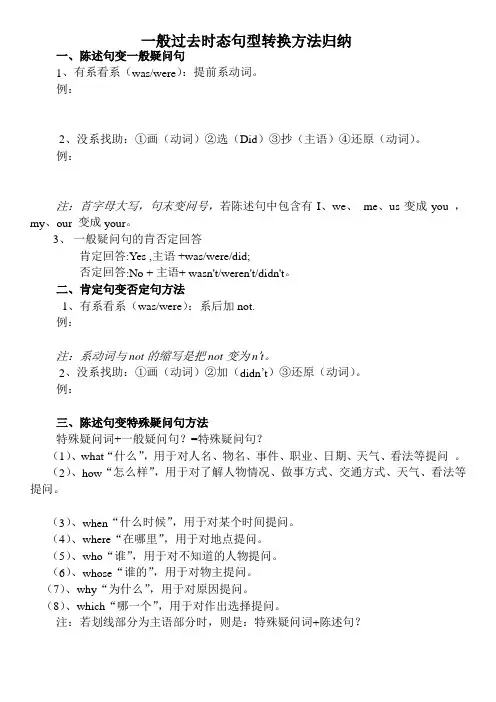
一般过去时态句型转换方法归纳
一、陈述句变一般疑问句
1、有系看系(was/were):提前系动词。
例:
2、没系找助:①画(动词)②选(Did)③抄(主语)④还原(动词)。
例:
注:首字母大写,句末变问号,若陈述句中包含有I、we、me、us变成you ,my、our 变成your。
3、一般疑问句的肯否定回答
肯定回答:Yes ,主语 +was/were/did;
否定回答:No + 主语+ wasn't/weren't/didn't。
二、肯定句变否定句方法
1、有系看系(was/were):系后加not.
例:
注:系动词与not的缩写是把not变为n’t。
2、没系找助:①画(动词)②加(didn’t)③还原(动词)。
例:
三、陈述句变特殊疑问句方法
特殊疑问词+一般疑问句?=特殊疑问句?
(1)、what“什么”,用于对人名、物名、事件、职业、日期、天气、看法等提问。
(2)、how“怎么样”,用于对了解人物情况、做事方式、交通方式、天气、看法等提问。
(3)、when“什么时候”,用于对某个时间提问。
(4)、where“在哪里”,用于对地点提问。
(5)、who“谁”,用于对不知道的人物提问。
(6)、whose“谁的”,用于对物主提问。
(7)、why“为什么”,用于对原因提问。
(8)、which“哪一个”,用于对作出选择提问。
注:若划线部分为主语部分时,则是:特殊疑问词+陈述句?。
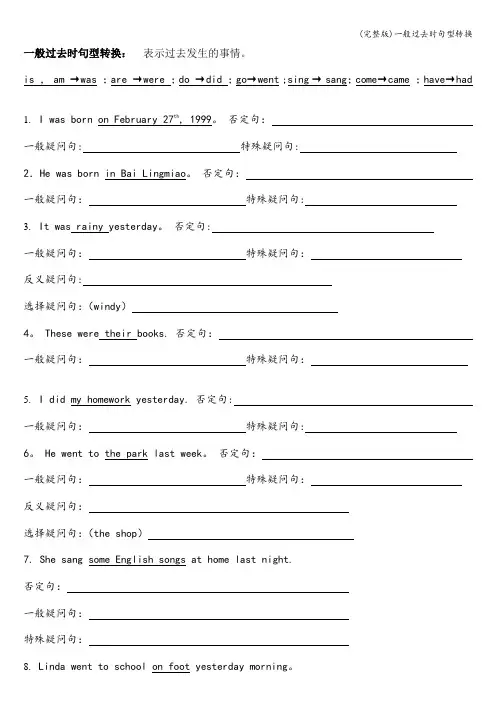
一般过去时句型转换:表示过去发生的事情。
is , am →was ;are →were ;do →did ;go→went ;sing → sang;come→came;have→had1.I was born on February 27th, 1999。
否定句:一般疑问句: 特殊疑问句:2.He was born in Bai Lingmiao。
否定句:一般疑问句:特殊疑问句:3.It was rainy yesterday。
否定句:一般疑问句:特殊疑问句:反义疑问句:选择疑问句:(windy)4。
These were their books. 否定句:一般疑问句:特殊疑问句:5.I did my homework yesterday. 否定句: 一般疑问句:特殊疑问句:6。
He went to the park last week。
否定句:一般疑问句:特殊疑问句:反义疑问句:选择疑问句:(the shop)7. She sang some English songs at home last night.否定句:一般疑问句:特殊疑问句:8.Linda went to school on foot yesterday morning。
否定句:一般疑问句:特殊疑问句:反义疑问句:选择疑问句:(by bike)9.They lived in a big house 10 years ago. 否定句: 一般疑问句:特殊疑问句:10.The twins liked swimming last year. 否定句: 一般疑问句:特殊疑问句:反义疑问句:选择疑问句:(running)11.There used to be lots of flowers in the garden years ago.否定句:一般疑问句:特殊疑问句:。
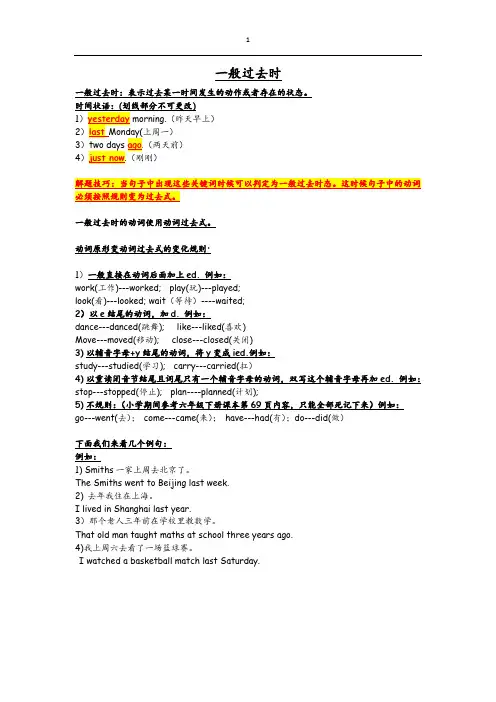
一般过去时一般过去时:表示过去某一时间发生的动作或者存在的状态。
一般过去时的动词使用动词过去式。
动词原形变动词过去式的变化规则:1)一般直接在动词后面加上ed. 例如:work(工作)---worked; play(玩)---played;look(看)---looked; wait(等待)----waited;2)以e结尾的动词,加d. 例如:dance---danced(跳舞); like---liked(喜欢)Move---moved(移动); close---closed(关闭)3)以辅音字母+y结尾的动词,将y变成ied.例如:study---studied(学习); carry---carried(扛)4)以重读闭音节结尾且词尾只有一个辅音字母的动词,双写这个辅音字母再加ed. 例如:stop---stopped(停止); plan----planned(计划);5)不规则:(小学期间参考六年级下册课本第69页内容,只能全部死记下来)例如:go---went(去);come---came(来);have---had(有);do---did(做)下面我们来看几个例句:例如:1) Smiths一家上周去北京了。
The Smiths went to Beijing last week.2) 去年我住在上海。
I lived in Shanghai last year.3)那个老人三年前在学校里教数学。
That old man taught maths at school three years ago.4)我上周六去看了一场篮球赛。
I watched a basketball match last Saturday.练习题:一、写出下列动词的过去式:make--- watch--- read--- fly--- talk--- fix--- study--- do--- have--- play--- eat---- drink--- work--- snow--- walk--- talk--- dance--- like---- carry--- draw--- wash--- know--- run--- come--- ride--- sit--- shop--- cut--- get--- go--- write--- swim--- put----二、请翻译下列句子:1)你上周末做了什么?我周六的时候打扫我的房间。
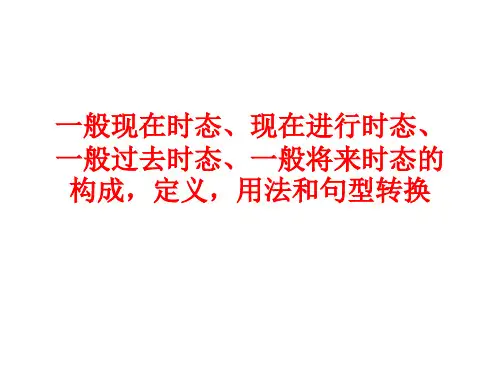
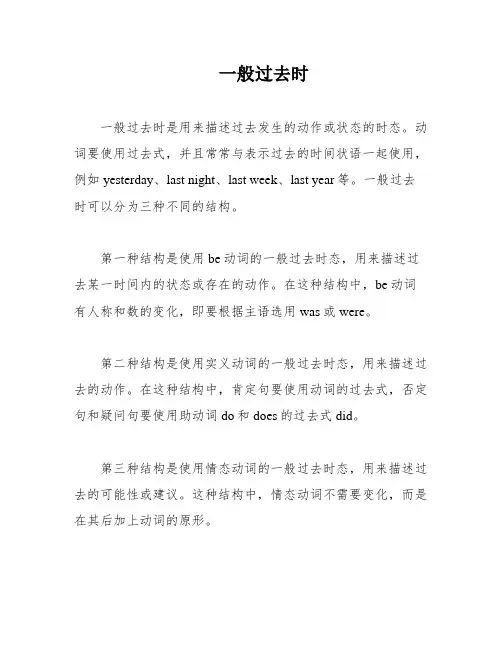
一般过去时一般过去时是用来描述过去发生的动作或状态的时态。
动词要使用过去式,并且常常与表示过去的时间状语一起使用,例如yesterday、last night、last week、last year等。
一般过去时可以分为三种不同的结构。
第一种结构是使用be动词的一般过去时态,用来描述过去某一时间内的状态或存在的动作。
在这种结构中,be动词有人称和数的变化,即要根据主语选用was或were。
第二种结构是使用实义动词的一般过去时态,用来描述过去的动作。
在这种结构中,肯定句要使用动词的过去式,否定句和疑问句要使用助动词do和does的过去式did。
第三种结构是使用情态动词的一般过去时态,用来描述过去的可能性或建议。
这种结构中,情态动词不需要变化,而是在其后加上动词的原形。
需要注意的是,在构成一般过去时的助动词did和didn't后面要跟动词的原形,而且do和does的过去时均为did。
因此,在使用一般过去时时,需要注意动词的形式和助动词的使用。
例如,原句“XXX.”可以改写为“XXX.”,否定句为“I didn’t do XXX.”,一般疑问句为“Did you do your homework yesterday?”,回答可以是“Yes。
I did.”或“No。
I didn’t.”。
1.情态动词的过去式为can→could。
may→might。
must→had to。
will→would。
should→should have。
2.特殊疑问句的构成形式有三种:a。
特殊疑问词+be过去式+主语+其他?b。
特殊疑问词+情态助动词过去式+主语+动词原形+其他?c。
特殊疑问词+do/does过去式+主语+动词原形+其他?例如:What was your former name?(你以前叫什么名字?)Why was he late for school last Monday?(上星期一他为什么迟到?)What could she do twenty years ago?(20年前她能做什么?)3.一般过去时的判断标志词包括:yesterday,the day before yesterday,last + 时间,this morning + 时间 + ago,just now,a moment ago,in + 过去的时间。
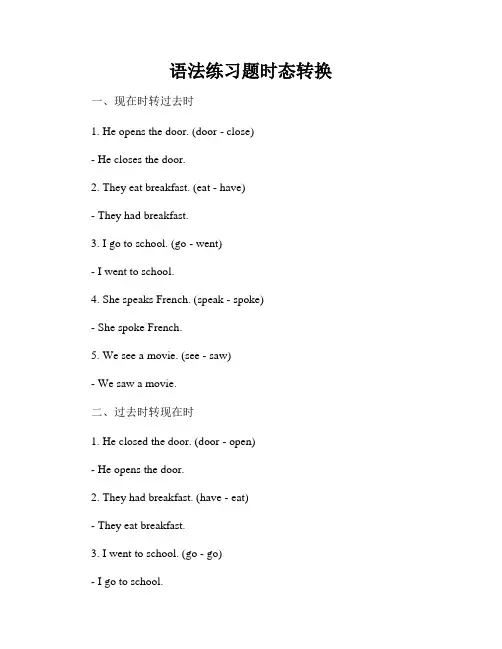
语法练习题时态转换一、现在时转过去时1. He opens the door. (door - close)- He closes the door.2. They eat breakfast. (eat - have)- They had breakfast.3. I go to school. (go - went)- I went to school.4. She speaks French. (speak - spoke)- She spoke French.5. We see a movie. (see - saw)- We saw a movie.二、过去时转现在时1. He closed the door. (door - open)- He opens the door.2. They had breakfast. (have - eat)- They eat breakfast.3. I went to school. (go - go)- I go to school.4. She spoke French. (speak - speak)- She speaks French.5. We saw a movie. (see - see)- We see a movie.三、现在进行时转过去进行时1. The children are playing in the park. (play - play)- The children were playing in the park.2. She is studying in the library. (study - study)- She was studying in the library.3. We are watching a movie at home. (watch - watch) - We were watching a movie at home.4. They are cooking dinner in the kitchen. (cook - cook) - They were cooking dinner in the kitchen.5. He is playing the guitar in his room. (play - play)- He was playing the guitar in his room.四、过去进行时转现在进行时1. The children were playing in the park. (play - play) - The children are playing in the park.2. She was studying in the library. (study - study)- She is studying in the library.3. We were watching a movie at home. (watch - watch)- We are watching a movie at home.4. They were cooking dinner in the kitchen. (cook - cook)- They are cooking dinner in the kitchen.5. He was playing the guitar in his room. (play - play)- He is playing the guitar in his room.五、将来时转过去时1. I will meet her tomorrow. (meet - met)- I met her.2. They will visit their grandparents next month. (visit - visited) - They visited their grandparents.3. She will finish the project next week. (finish - finished)- She finished the project.4. We will travel to Europe next year. (travel - traveled)- We traveled to Europe.5. He will buy a new car next week. (buy - bought)- He bought a new car.六、过去完成时转现在完成时1. I had finished my homework. (finish - finish) - I have finished my homework.2. They had gone to the beach. (go - go)- They have gone to the beach.3. She had read the book. (read - read)- She has read the book.4. We had eaten lunch. (eat - eat)- We have eaten lunch.5. He had written a letter. (write - write)- He has written a letter.七、现在完成时转过去完成时1. I have finished my homework. (finish - finish) - I had finished my homework.2. They have gone to the beach. (go - go)- They had gone to the beach.3. She has read the book. (read - read)- She had read the book.4. We have eaten lunch. (eat - eat)- We had eaten lunch.5. He has written a letter. (write - write)- He had written a letter.总结:语法练习题中的时态转换对于英语学习者来说是非常重要的。

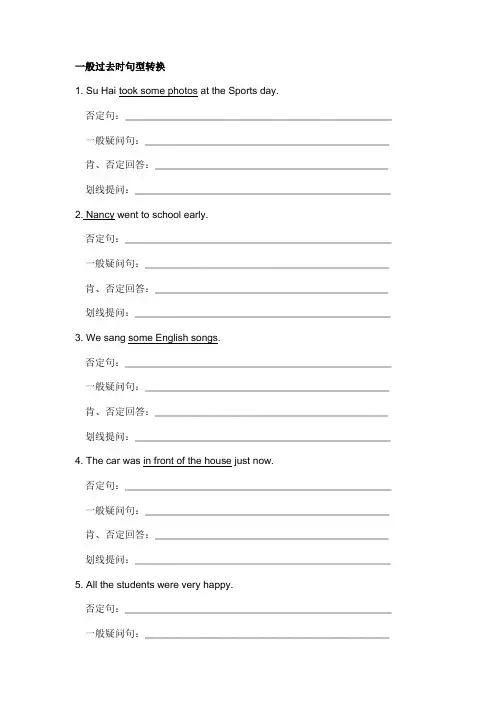
一般过去时句型转换1. Su Hai took some photos at the Sports day.否定句:________________________________________________ 一般疑问句:____________________________________________ 肯、否定回答:__________________________________________ 划线提问:______________________________________________ 2. Nancy went to school early.否定句:________________________________________________ 一般疑问句:____________________________________________ 肯、否定回答:__________________________________________ 划线提问:______________________________________________ 3. We sang some English songs.否定句:________________________________________________ 一般疑问句:____________________________________________ 肯、否定回答:__________________________________________ 划线提问:______________________________________________ 4. The car was in front of the house just now.否定句:________________________________________________ 一般疑问句:____________________________________________ 肯、否定回答:__________________________________________ 划线提问:______________________________________________ 5. All the students were very happy.否定句:________________________________________________ 一般疑问句:____________________________________________6.They were in his pocket.否定句:________________________________________________ 一般疑问句:____________________________________________ 肯、否定回答:__________________________________________ 划线提问:______________________________________________ 7. They played football in the playground.否定句:________________________________________________ 一般疑问句:____________________________________________ 肯、否定回答:__________________________________________ 划线提问:______________________________________________ 8. He went out ten minutes ago.否定句:________________________________________________ 一般疑问句:____________________________________________ 肯、否定回答:__________________________________________ 划线提问:______________________________________________ 9. I bought a VCD last month.否定句:________________________________________________ 一般疑问句:____________________________________________ 肯、否定回答:__________________________________________ 划线提问:______________________________________________ 10.The children had a good time in the park.否定句:________________________________________________ 一般疑问句:____________________________________________划线提问:______________________________________________ 11. Ann did her homework yesterday evening.否定句:________________________________________________ 一般疑问句:____________________________________________ 肯、否定回答:__________________________________________ 划线提问:______________________________________________ st week I read an English book.否定句:________________________________________________ 一般疑问句:____________________________________________ 肯、否定回答:__________________________________________ 划线提问:______________________________________________ 13. My brother was in the zoo just now.否定句:________________________________________________ 一般疑问句:____________________________________________ 肯、否定回答:__________________________________________ 划线提问:______________________________________________ 14.She had some bread for lunch today.否定句:________________________________________________ 一般疑问句:____________________________________________ 肯、否定回答:__________________________________________ 划线提问:______________________________________________ 15.There were some flowers in the garden.否定句:________________________________________________一般疑问句:____________________________________________ 肯、否定回答:__________________________________________ 16. She could finish her homework by herself.否定句:________________________________________________ 一般疑问句:____________________________________________ 肯、否定回答:__________________________________________ 17. They were good friend .否定句:________________________________________________ 一般疑问句:____________________________________________ 肯、否定回答:__________________________________________ 划线提问:______________________________________________ 18.We saw a film with our teacher.否定句:________________________________________________ 一般疑问句:____________________________________________ 肯、否定回答:__________________________________________ 划线提问:______________________________________________ 19. We listened to music the whole night .否定句:________________________________________________ 一般疑问句:____________________________________________ 肯、否定回答:__________________________________________ 划线提问:______________________________________________ 20. She arrived there at 9:00 that day .否定句:________________________________________________ 一般疑问句:____________________________________________。
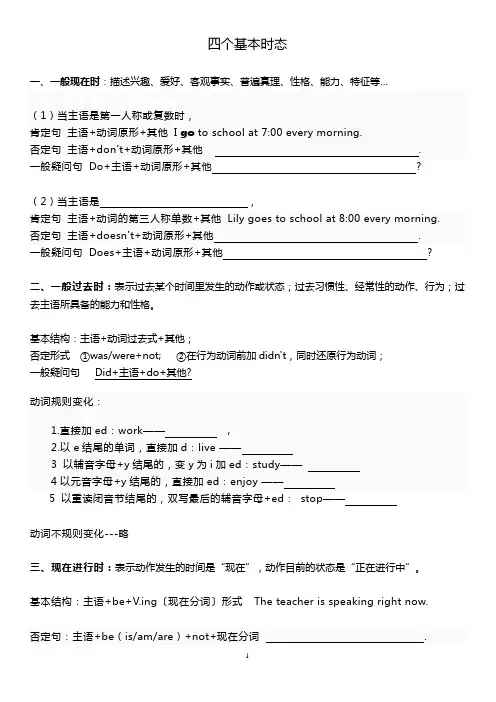
四个基本时态一、一般现在时:描述兴趣、爱好、客观事实、普遍真理、性格、能力、特征等…(1)当主语是第一人称或复数时,肯定句主语+动词原形+其他I go to school at 7:00 every morning.否定句主语+don't+动词原形+其他.一般疑问句Do+主语+动词原形+其他?其他?二、一般过去时:表示过去某个时间里发生的动作或状态;过去习惯性、经常性的动作、行为;过去主语所具备的能力和性格。
基本结构:主语+动词过去式+其他;否定形式①was/were+not; ②在行为动词前加didn't,同时还原行为动词;一般疑问句Did+主语+do+其他?5 以重读闭音节结尾的,双写最后的辅音字母+ed:stop——动词不规则变化---略三、现在进行时:表示动作发生的时间是“现在”,动作目前的状态是“正在进行中”。
基本结构:主语+be+V.ing〔现在分词〕形式The teacher is speaking right now.+Sth? .四、一般将来时:表示将来某一时刻的动作或状态,或将来某一段时间内经常的动作或状态。
常常和表示将来的时间状语连用。
如:tomorrow(明天),next week(下周),from now on(从现在开始);in the future(将来)等。
(1)“will+动词原形”表示将来发生的事情,用于征求对方的意见或表示客气的邀请。
We will go to Disneyland next month.(2).“be going to+动词原形”表示即将发生的或最近打算进行的事。
例如We're going to meet outside the school gate. 我们打算在校门口见面。
Look! . 瞧!快下雨了。
(3)be about to 表示即将发生的动作,意为:很快,马上。
They leave. (=They're going to leave.) 他们就要走了。
二.一般过去时定义:表示在过去的时间发生的事情或者存在的状态句型结构一:主语+系动词+表语系动词: be动词:was, weream→wasis→wasare→were*be动词的搭配:I 用am, you 用are,is分给he,she,it;复数全部都用are。
例1:Iwas amiddle school student.例2:You werefromChina.例3:She was the best student in our class.例4:We were close friends.句型转换:变为否定句:I was not a middleschool student.(在be动词后加not)变为一般疑问句:Were you a middleschool student?(be动词提前,其它不变)回答: Yes, I was.No, I wasnot.句型结构二:主语+谓语动词+(宾语)谓语动词: 动词过去式动词过去式的变化规则:1.在词尾+ed,如watch→watched;2.当动词以“辅音+y”结尾时,改“y”为“i”并在词尾+ed, 如study→studied;3.当动词以“辅音+e”结尾时,直接+d, 如like→liked;4.当动词是重读闭音节结尾且词尾只有一个辅音时,双写最后一个辅音+ed,如stop→stopped;5.不规则变化:①have→had②do→did③go→went例5:Mymum came home late last night.例6:I hadmanyfriends inmy hometown.例7: Lily watched TV withher family yesterday afternoon.句型转换:变为否定句:Mymum did not come home late lastnight. (在谓语动词前加did not,动词变成原型)变为一般疑问句:Did your mum comehome latelastnight?(在整个句子前加Did, 动词变成原型)回答:Yes,she did.No,she didn’t.特殊疑问句的变化规则:三步走,一换二代三提前例1:Martinwas in the park just then.(对划线部分提问)一换:换成一般疑问句WasMartin inthe parkjust then?二代:把划线部分用特殊疑问词代入Wastin in thepark just then?where三提前:把特殊疑问词提前Where was Martin just then?练习一:请把例2、3、4、6、7改成否定句、一般疑问句及其回答。
英语语法-⼀般过去时态英语语法————⼀般过去时态⼀.定义:⼀般过去时表⽰过去某个时间发⽣的动作或存在的状态。
常和表⽰过去的时间状语连⽤。
如:last year, yesterday等;也可表⽰过去经常反复发⽣的动作,常和often, always等频率副词连⽤⼆⽤法:(1)表⽰过去某⼀时刻或某⼀段时间内所发⽣的动作或情况,通常⼀般过去式带有表⽰动作时间状语的词,词组或从句,如yesterday, the day before last, last week, two days ago 等,上下⽂清楚时可以不带时间状语。
I worked in that factory last year. 去年我在那⼀家⼯⼚⼯作。
I went to the Tian Long Mountain yesterday. 昨天我们去了天龙⼭。
(2)⼀般过去时态:表⽰过去某⼀时间所发⽣的动作或存在的状态。
谓语动词要⽤⼀般过去式。
时间标志:yesterday(昨天), last week(上周), last month(上个⽉), last year(去年), two months ago (两个⽉前), the day before yesterday(前天),in 1990 (在1990年), in those days (在那些⽇⼦⾥), just now (刚才) , that day , this morning 等表⽰过去的时间状语。
如: I was born in 1990. (我出⽣在1990年)。
When did you go to the park? (你是什么时候去的公园)。
I went to the park last week. (我是上周去的公园)在上⾯的句⼦中第⼀句属于be动词的⼀般过去时态;第⼆句和第三句属于实义动词的⼀般过去时态。
三.句型结构1. Be 动词的⼀般过去时态在没有实义动词的句⼦中使⽤be动词, am is 的过去式为was; are的过去式为were.构成:肯定句:主语+was (were) +宾语 ,如:I was late yesterday. (昨天我迟到了。
人称代词用来代替表示人或事物的名词,以便不再重复使用名词。
1)人称代词的主格在句子中作主语用法举例:1.My name is Millie. I live in Beijing. ( I代自己, Millie )2. Sandy, do you know where Mr Wu is? ( you代Sandy )3. Simon loves football. He is a member of the football team.4. Millie loves Eddie. She looks after him every day. (she 代Millie)5. This book is very interesting. It is about cartoons. (it 代this book)6. I am Daniel and this is Amy. We are in Class 1, Grade7. (we 代替Amy and I)2)人称代词的宾格在句子中作宾语(放在动词后面或者介词后面)1.Tell me the answer, please.(动词后面)2.Let’s go.(=let us go) (动词后面)3. Look at him. He is funny! (介词后面)物主代词的定义:物主代词实际上是人称代词的所有格形式。
物主代词可以分为形容词性和名词性两种。
形容词性物主代词一定要后接名词(如:This is my book. 这是我的书。
),名词性物主代词可以独立使用,无需后接名词(如:This book is mine. 这本书是我的。
)。
3) 形容词性物主代词一般位于名词前,用作定语,限定该名词的意义This is my book.4) 名词性物主代词的句法功能a. 作主语,例如:May I use your pen? Mine is broken.(mine=my pen)我可以用一用你的钢笔吗?我的坏了。
四种过去时态的讲解及习题(一)一般过去时一、一般过去时1.一般过去时表示过去某个时间发生的动作或存在的状态,常和表示过去的时间状语连用。
一般过去时也表示过去经常或反复发生的动作。
2.Be动词在一般过去时中的变化:⑴am 和is在一般过去时中变为was。
(was not=wasn't)⑵are在一般过去时中变为were。
(were not=weren't)⑶带有was或were的句子,其否定、疑问的变化和is, am, are一样,即否定句在was或were后加not,一般疑问句把was或were调到句首。
3.句中没有be动词的一般过去时的句子否定句:didn't +动词原形,如:Jim went home yesterday.Jim didn't go home yesterday.一般疑问句:在句首加did,句子中的动词过去式变回原形。
如:Jim went home yesterday.Did Jim go home yesterday?特殊疑问句:⑴疑问词+一般疑问句?如:Jim went home yesterday.Did Jim go home yesterday?What did Jim do yesterday?动词过去式变化规则:1.一般在动词末尾加-ed,如:pull-pulled, cook-cooked2.结尾是e加d,如:taste-tasted3.末尾是辅音字母加一个元音字母和一个辅音字母的重读闭音节,应双写末尾的辅音字母,再加-ed,如:stop-stopped4.以“辅音字母+y”结尾的,变y为i,再加-ed,如:study-studied5.不规则动词过去式:一般过去时练习Be动词的过去时练习(1)一、用be动词的适当形式填空1.I _______ at school just now.2.He ________ at the camp last week.3.We ________ students two years ago.4.They ________ on the farm a moment ago.5.Yang Ling ________ eleven years old last year.6.There ________ an apple on the plate yesterday.7.There ________ some milk in the fridge on Sunday.8.The mobile phone _______ on the sofa yesterday evening.二、句型转换1. It was exciting.否定句:________________________________________________ 一般疑问句:____________________________________________ 肯、否定回答:__________________________________________ 2. All the students were very excited.否定句:________________________________________________ 一般疑问句:____________________________________________ 肯、否定回答:__________________________________________ 3. They were in his pocket.否定句:________________________________________________ 一般疑问句:____________________________________________ 肯、否定回答:__________________________________________ Be动词的过去时练习(2)一、用be动词的适当形式填空1.I ______ an English teacher now.2.She _______ happy yesterday.3.They _______ glad to see each other last month.4.Helen and Nancy ________ good friends.5.The little dog _______ two years old this year.6.Look, there ________ lots of grapes here.7.There ________ a sign on the chair on Monday..8.Today _______ the second of June. Yesterday ______ the first of June. It _____ Children's Day. All the students ______ very excited.二、句型转换1. There was a car in front of the house just now.否定句:________________________________________________一般疑问句:____________________________________________肯、否定回答:__________________________________________肯、否定回答:__________________________________________三、中译英1. 我的故事书刚才还在手表旁边。
一般过去时的知识点归纳一般过去时是英语中常见的时态之一,用于描述过去发生的动作、事件或状态。
理解和掌握一般过去时对于我们正确表达过去的经历和故事非常重要。
下面就来详细归纳一下一般过去时的相关知识点。
一、一般过去时的定义和构成一般过去时表示过去某个时间发生的动作或存在的状态。
它通常与表示过去的时间状语连用,如 yesterday(昨天)、last week(上周)、two days ago(两天前)等。
一般过去时的构成分为两种情况:1、对于 be 动词(was / were)第一人称单数(I)和第三人称单数(he、she、it)用 was。
第二人称单数(you)和所有人称的复数(we、you、they)用 were。
例如:I was at home yesterday(我昨天在家。
) They were very happy last night(他们昨晚很开心。
)2、对于实义动词动词的过去式形式。
大多数动词的过去式是在动词原形后加 ed,如 play played,work worked 。
但也有一些不规则动词,它们的过去式需要特殊记忆,比如 go went,have had ,do did 等。
例如:He played football last weekend(他上周末踢足球了。
) She had a big party last month(她上个月举办了一个大型聚会。
)二、一般过去时的用法1、表示过去某个特定时间发生的动作或存在的状态。
例如:I met him in the street yesterday(昨天我在街上遇见了他。
)2、表示过去经常或反复发生的动作。
例如:He often went swimming when he was a child(他小时候经常去游泳。
)3、在时间、条件状语从句中,表示过去将来的动作。
例如:She said she would come if she had time(她说如果有时间她会来。
一般现在时和一般过去时的句型转换1. 生活中的小故事生活中,我们常常需要用不同的时态来表达事情,今天就聊聊一般现在时和一般过去时的那些事儿。
就比如说,你每天早上都喝咖啡,对吧?你可以说:“我每天都喝咖啡。
”这是一般现在时,简单明了。
可是,回想一下,上个月的那个星期六,你去咖啡店时,可能会说:“我那天喝了咖啡。
”这就变成了一般过去时。
看到没,这种转换就像魔术一样,轻而易举!1.1. 早晨的咖啡时光想象一下,一个阳光明媚的早晨,你懒洋洋地躺在床上,心里想着:“我总是喜欢在早晨喝一杯热腾腾的咖啡。
”这是一种习惯,反映了你的一般现在时。
可是一转眼,时光倒流,回到上个月,那时候你可真是被咖啡圈了个彻底:“上个月我在新开的咖啡店喝了一杯超好喝的拿铁。
”说到那杯拿铁,真的是香气四溢,瞬间把我拉回到那个瞬间。
想想现在的自己,一杯咖啡在手,简直是人生的赢家,哈哈!1.2. 每天的跑步计划再说说运动,哦,运动这事儿。
你可能会说:“我每天早上都去跑步。
”这是个健康的习惯啊,大家都应该学学!可是回想一下,上个星期日,你就得改口:“我上个星期日去跑了十公里!”这时候的你,脸上肯定挂着得意的笑容,仿佛刚刚完成了一项伟大的壮举,心里想着:“我真是太棒了!”一想到这些,立刻充满了动力,想要继续努力!2. 生活中的变化生活中,总是充满了变化。
现在的你也许正在学习新东西:“我现在正在学吉他。
”可是,想想去年,你可能会说:“去年我学了一整年的吉他。
”这种时态的变化就像一个时间的漩涡,把你带回到过去,又拉回现在。
这种对比,真是让人感慨万千。
2.1. 学习的乐趣想想现在,可能你在乐队里练习:“我现在和我的朋友们一起排练。
”可是,上个学期,你可得说:“上个学期我们常常一起排练。
”那种团结的气氛,真是让人怀念。
一起挥洒汗水,一起欢笑,生活中能有这样的伙伴,真是太幸福了。
学吉他不仅仅是技术上的提升,更是和朋友们一起享受音乐的乐趣!2.2. 饮食的变化再说到饮食习惯。
I.句型转换1. The children had a good time in the park.否定句:______________________________________一般疑问句:________________________________________ 对划线部分提问:__________________________________2. There were about nine hundred people at the concert.(音乐会) 否定句:__________________________________________一般疑问句:________________________________________ 对划线部分提问:____________________________________3. There was only one problem.否定句:__________________________________________一般疑问句:________________________________________ 肯定/否定回答:____________________________________4. Ann did her homeworkyesterday evening.否定句:__________________________________________一般疑问句:________________________________________ 对划线部分提问:____________________________________对划线部分提问:____________________________________5. Last week I read an English book.否定句:_________________________________________一般疑问句:________________________________________ 肯定/否定回答:____________________________________对划线部分提问:____________________________________对划线部分提问:____________________________________6. My brother was in the park just now.否定句:__________________________________________一般疑问句:________________________________________ 肯定/否定回答:____________________________________对划线部分提问:____________________________________对划线部分提问:____________________________________ 7. She had some bread for lunch today.否定句:__________________________________________一般疑问句:________________________________________肯定/否定回答:____________________________________对划线部分提问:____________________________________8. They read English last night.否定句:__________________________________________一般疑问句:________________________________________肯定/否定回答:____________________________________对划线部分提问:____________________________________II. 用所给词的适当形式填空。
1. Tom and Mary ___________ (come) to China last month.2. Mike _________________(not go) to bed until 12 o’clock last night.So he ______ (get ) up late.3. Mary __________ (read) English yesterday morning.4. There _________ (be) no one here a moment ago.5. I ___________ (call) Mike this morning.6. I listened but ___________ (hear) nothing.7. Tom ___________ (begin) to learn Chinese last year.8. Last week we _________ (pick) many apples on the farm.9. My mother ________________ (not do) housework yesterday.10. She watches TV every evening. But she __________ (not watch) TV last night. 11.________ your father ________ ( go ) to work every day last year?12.--What time _______ you _______ (get) to Beijing yesterday?--We __________ (get) to Beijing at 9:00 in the evening.13. What __________ (make) him cry (哭) just now?14. Last year the teacher _________ (tell) us that the earth moves around the sun.15. There ____________ a telephone call for you just now. (be)16. There __________ not enough people to pick apples that day. ( be)17. There _____________( be not) any hospitals in my hometown (家乡) in 1940.18. There ____________ enough milk at home last week, wasn’t there?19. Eli ____________ to Japan last week.( move)20. –When _______ you _________ (come) to china?--Last year.21. Did she ________ (have) supper at home?22. Jack ____________ (not clean) the room just now.23. _________ (be) it cold in your city yesterday?24. How many people ________ (be) there in your class last term?25. It ________ (be) hot yesterday and most children _______ (be) outside.26. There ________ (be) a football match on TV yesterday evening, but I_________ (have) no time to watch it.27. What ________ Tom ________ (do) on Saturday evening?He ________(watch) TV and__________(read) an interesting book.28. They all _________(go) to the mountains yesterday morning.29. She _________(not visit) her aunt last weekend. She ________ (stay) at home and _________(do) some cleaning.30. When ________ you _________(write) this song?I __________(write) it last year.There be结构练习题1.桌子上有一本书和两支钢笔。
There ______ a book and ______ ______ on the desk.2.在吉姆的书包里有一些书。
______ ______ ______ ______ in Jim’s bag.3.书包里有一些地图吗?______ ______ ______ ______ in the bag?4.我们学校有许多学生。
There ______ many ______ in our school.5.树上没有鸟。
There ______ ______ birds in the tree.6.在老师的办公室中有一张桌子。
There ______ ______ ______ in the teachers’ office.7.在桌子上有些书。
There are ______ ______ on the desk.8.在你的课桌上有一块橡皮和两把尺子。
There ______ ______ ______ and ______ on your desk.9.在铅笔盒有几支铅笔和一支钢笔。
______ ______ ______ ______ and a pen in the pencil-box. 10.我们的教室里没有一台电脑。
______ ______ ______ ______ in our classroom.do- watch- go- learn- type-teach- visit- speak-have- work-write- can- play- come- drop-find- spend- see- begin- win-stay- keep- feed- sweep- wash- clean- is/am- don't- are- wait-surprise- get- count- read- sit-can't- talk- think- call- fly-want- help- finish- study- walk-stand- love- arrive- take- climb-give- phone- plant- become- run-meet- ask- make-crawl- lie-eat- sleep- fall- start- listen- graduate- cook- buy- rain- swim- say- happen- miss- send- dance- hurry- wake- jump- put- shout-。